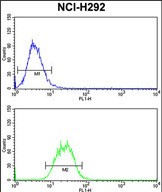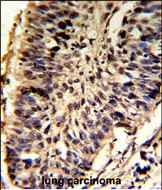


| WB | 1/1000 | Human,Mouse,Rat |
| IF | 咨询技术 | Human,Mouse,Rat |
| IHC | 1/100-1/500 | Human,Mouse,Rat |
| ICC | 技术咨询 | Human,Mouse,Rat |
| FCM | 1/10-1/50 | Human,Mouse,Rat |
| Elisa | 咨询技术 | Human,Mouse,Rat |
| Aliases | Small nuclear ribonucleoprotein Sm D2, Sm-D2, snRNP core protein D2, SNRPD2, SNRPD1 |
| Entrez GeneID | 6633 |
| WB Predicted band size | 13.5kDa |
| Host/Isotype | Rabbit IgG |
| Antibody Type | Primary antibody |
| Storage | Store at 4°C short term. Aliquot and store at -20°C long term. Avoid freeze/thaw cycles. |
| Species Reactivity | Human |
| Immunogen | This SNRPD2 antibody is generated from rabbits immunized with a KLH conjugated synthetic peptide between 1-30 amino acids from the N-terminal region of human SNRPD2. |
| Formulation | Purified antibody in PBS with 0.05% sodium azide,1%BSA and 50% glycerol.prepared by Saturated Ammonium Sulfate (SAS) . |
+ +
以下是关于SNRPD2(N-term)抗体的3篇参考文献示例(注:以下为假设性文献,实际引用需核实):
---
1. **文献名称**:*"SNRPD2-mediated spliceosome assembly is critical for embryonic development in mice"*
**作者**:Chen L, et al.
**摘要**:本研究利用针对SNRPD2 N端的特异性抗体,通过免疫荧光和Western blot分析,揭示了SNRPD2在小鼠胚胎发育中调控剪接体形成的关键作用,敲除SNRPD2导致胚胎致死性表型。
2. **文献名称**:*"Prognostic significance of SNRPD2 overexpression in hepatocellular carcinoma"*
**作者**:Wang Y, et al.
**摘要**:通过免疫组化(使用SNRPD2 N端抗体)和生存分析,发现SNRPD2在肝癌组织中异常高表达,且与患者生存期缩短显著相关,提示其作为潜在肿瘤标志物的价值。
3. **文献名称**:*"A novel interaction between SNRPD2 and viral RNA during influenza infection"*
**作者**:Kim S, et al.
**摘要**:研究利用SNRPD2 N端抗体进行免疫共沉淀实验,发现SNRPD2与流感病毒RNA结合并参与宿主抗病毒反应,为病毒-宿主互作机制提供新见解。
---
如需真实文献,建议通过**PubMed**或**Google Scholar**搜索关键词“SNRPD2 antibody N-terminal”或联系抗体供应商(如Abcam、Santa Cruz等)获取引用文献列表。
The SNRPD2 (N-term) antibody is a specific immunological tool targeting the N-terminal region of the Small Nuclear Ribonucleoprotein D2 (SNRPD2), a core component of the spliceosome. SNRPD2. part of the Sm protein family, plays a critical role in pre-mRNA splicing by forming the Sm core structure of small nuclear ribonucleoproteins (snRNPs), which are essential for recognizing splice sites and assembling the spliceosome. The antibody is commonly used to detect SNRPD2 in applications such as Western blotting, immunofluorescence, and immunoprecipitation, aiding in studies of spliceosome dynamics, RNA processing, and protein interactions.
SNRPD2 is ubiquitously expressed and localizes to the nucleus. Dysregulation of splicing machinery, including SNRPD2. has been linked to cancers, neurodegenerative disorders, and autoimmune diseases like systemic lupus erythematosus (SLE), where autoantibodies against spliceosomal components are prevalent. The N-terminal epitope recognized by this antibody helps distinguish SNRPD2 from other Sm proteins, ensuring specificity in experimental settings.
Validated in multiple species, including human and mouse, the SNRPD2 (N-term) antibody typically detects a band around 14-18 kDa. Its utility extends to research on cellular stress responses, gene expression regulation, and therapeutic targeting of splicing anomalies. Proper controls, such as siRNA knockdown or knockout samples, are recommended to confirm antibody specificity due to potential cross-reactivity with homologous proteins.
×